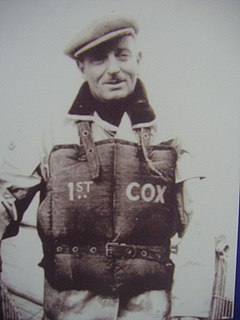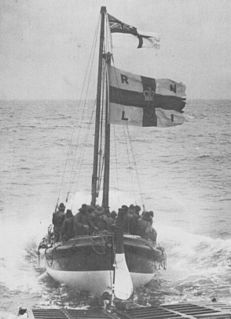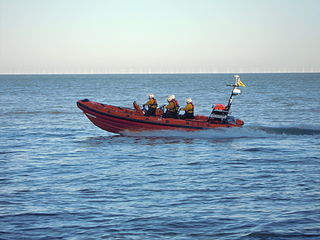This is a list of notable RNLB coastal rescue lifeboats.
Where applicable, their Official Number (or 'ON') is also given.

Odd Fellows is an international fraternity consisting of lodges first documented in 1730 in London. The first known lodge was called Loyal Aristarcus Lodge No. 9, suggesting there were earlier ones in the 18th century. Notwithstanding, convivial meetings were held "in much revelry and, often as not, the calling of the Watch to restore order." Names of several British pubs today suggest past Odd Fellows affiliations. In the mid-18th century, following the Jacobite risings, the fraternity split into the rivaling Order of Patriotic Oddfellows in southern England, favouring William III of England, and the Ancient Order of Oddfellows in northern England and Scotland, favouring the House of Stuart.

The Independent Order of Oddfellows Manchester Unity Friendly Society Limited, also called the Manchester Unity of Oddfellows; trading as The Oddfellows, is a fraternal order founded in Manchester in 1810.
RNLB Mary Stanford was a Royal National Lifeboat Institution (RNLI) Liverpool-class pulling and sailing type lifeboat stationed in Rye Harbour.

Henry "Shrimp" Thomas Davies BEM was a lifeboatman from Cromer on the north coast of Norfolk, England. His uncle, Henry Blogg, gave him the nickname "Shrimp" after seeing him as a tiny baby. In 1931 he joined the crew of the Cromer lifeboat H F Bailey and became coxswain in 1947, taking over from Henry Blogg. Davies retired in February 1976, after serving as coxswain of lifeboats Henry Blogg and Ruby and Arthur Reed, having been one of Cromer Lifeboat Station's longest serving coxswains.

RNLB H F Bailey is the most famous Royal National Lifeboat Institution (RNLI) lifeboat to have served from Cromer, because she was used by Coxswain Henry Blogg to perform many of his most famous lifesaving exploits. The lifeboat was on station for the ten years between 1935 and 1945. She is now part of the National Historic Fleet and has been preserved in the RNLI Henry Blogg Museum in Cromer.

RNLB H F Bailey was the first Royal National Lifeboat Institution (RNLI) lifeboat powered by a motor, that served from Cromer Lifeboat Station.

RNLB H F Bailey was the second lifeboat at Cromer in the county of Norfolk to bear the name of H F Bailey. She replaced H F Bailey which had been stationed at Cromer until 1924. In 1936 she became the station's reserve lifeboat and was renamed J B Proudfoot.

RNLB Henry Blogg was the eighteenth lifeboat to be stationed at Cromer in the county of Norfolk.

RNLB Ruby and Arthur Reed II was a Tyne-class lifeboat stationed at Cromer in the English county of Norfolk from 16 December 1985 and was the No 1 lifeboat between various relief’s until she was replaced after 21 years service by the Tamar-class RNLB Lester (ON 1287) in December 2007. Between 1996 and 1999, during the rebuilding of the pier head lifeboat house and slipway, she was temporarily replaced by a carriage launched Mersey-class lifeboat, RNLB Her Majesty The Queen (ON 1189). During the time that the Ruby and Arthur Reed was on station at Cromer she performed 120 service launches, rescuing 102 lives including 3 dogs. Nearly 50% of her launches took place during the hours of darkness and 17 of them saw her facing gale force 7 winds. Her service launches included helping 48 merchant and fishing vessels and 47 pleasure craft.

Ruby and Arthur Reed was an Oakley-class lifeboat of the Royal National Lifeboat Institution (RNLI) stationed at Cromer in the English county of Norfolk from 30 April 1967 and was the No 1 lifeboat between various relief’s until she was replaced after 17 years service by the Tyne-class Ruby and Arthur Reed II on 16 December 1985. During the time that the Ruby and Arthur Reed was on station at Cromer she performed 125 service launches, rescuing 58 lives.

The Oakley-class lifeboat refers to two types of self-righting lifeboat operated by the Royal National Lifeboat Institution (RNLI) around the coast of the United Kingdom and Ireland between 1958 and 1993. The 37-foot (11.3 m) Oakley was designed for carriage launching, while the larger 48-foot-6-inch (14.8 m) version was designed for slipway launching or to lie afloat. During their service they saved a combined total of 1,456 lives in 3,734 rescue launches.

The Manchester Unity of Oddfellows was an Oakley-class lifeboat of the Royal National Lifeboat Institution (RNLI) stationed at Sheringham in the English county of Norfolk from 10 July 1961 until 1990 when she was replaced after 29 years service by an Atlantic 75 second generation Rigid Inflatable Boat (RIB) in May 1992. During the time that The Manchester Unity of Oddfellows was on station at Sheringham, she performed 127 service launches, rescuing 134 lives.

RNLB Lloyds II was an Oakley-class lifeboat of the Royal National Lifeboat Institution (RNLI) stationed at Sheringham in the English county of Norfolk from 8 October 1990 until April 1992, when she was replaced by the Atlantic 75 second generation Rigid Inflatable Boat (RIB) Manchester Unity of Oddfellows in April 1992. During the time that the Lloyds II was on station at Sheringham, she performed 13 service launches.

RNLB J C Madge was a Liverpool-class, non-self righting lifeboat stationed at Sheringham in the English county of Norfolk from December 1904 until June 1936 during which time she was launched on service 34 times and saved 58 lives. J C Madge was replaced by Forester’s Centenary (ON 786).

Wells-next-the-Sea Lifeboat Station is a lifeboat station in the town of Wells-next-the-Sea in the English county of Norfolk. The station, run by the Royal National Lifeboat Institution, operates both inshore and offshore lifeboats. The inshore boat is called Jane Ann III (D-661) and is a D-class (IB1) lifeboat, whilst the offshore boat is called Doris M, Mann of Ampthill (ON 1161), and is a Mersey class lifeboat. The station boathouse is located at the beach on the western side of Wells Harbour mouth.

RNLB The Oddfellows (B-818) is the current rigid-inflatable inshore lifeboat on station at the English coastal town of Sheringham in the county of Norfolk in the United Kingdom.
RNLB Manchester Unity of Oddfellows (B-702) was an Atlantic 75-class lifeboat rigid-inflatable inshore lifeboat on station at the English coastal town of Sheringham in the county of Norfolk in the United Kingdom. The boat was a permanent replacement for the Atlantic 21-class lifeboat RNLB B-536 which served at Sheringham from 29 January 1994.
RNLB H F Bailey II was the third lifeboat stationed at Cromer to bear this name, but the first of the four to bear a number in its name. This lifeboat was sent to replace H F Bailey. Coxswain Henry Blogg of the Cromer is often referred to as "the greatest of the lifeboatmen" was said to have disliked this lifeboat having preferred the previous lifeboat H F Bailey ON 695.
Several lifeboats of the RNLI have been named RNLB H F Bailey,
John Frederick Stanford (1815–1880) was an English barrister, literary scholar and politician.